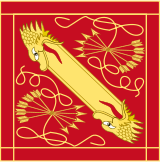Royal Band of Castile Later use of the Royal Band of Castile See also References Navigation menuBand of Castile. Alcázar de BriosaThe Bend of Castile of Catolic Monarchs, Spanish Navy website. (In Spanish)ArchivedStandard and guindon of Francisco Franco, Flags of the Worldwww.ctv.es (Fundación Francisco Franco), Arms Imagewww.generalisimofranco.com, Arms image
Personal flags of Spain14th-century establishments in CastileHeraldic charges
heraldic flagCrown of CastileCastileLeonese armsAlfonso XI of CastileCounts of CastilegulesbatonScipioHispaniaOrder of the Royal Band of CastileCharles V, Holy Roman EmpireHenry IV of CastilepurplebenddragonsPeter of CastileHenry Idragonwolf

The Royal Band of Castile of the kingdom of Castile.
The Royal Band of Castile (Banda Real de Castilla) was the heraldic flag of the monarchs of the Crown of Castile, a personal banner of military use, distinctive indicating to the troops the presence of the monarch and allowed them to have identified his position in the battles. This insignia, who joined in the symbolism of the king of Castile to heraldic flag with the Castile and Leonese arms, was created in 1332 by the king Alfonso XI of Castile, although its origin probably would go back to one of the primitive symbols of the Counts of Castile, which had consisted of a gold bend on gules (red). The dragantes appeared on the handpiece or baton when Scipio brought the Roman legions to Hispania.
Alfonso XI founded the Order of the Royal Band of Castile to reward the best services to the sovereign.
The Band of Castile was used by all the monarchs that had Castile until Charles V, Holy Roman Empire. It consisted, from the reign of Henry IV of Castile, on a reddish flag, probably purple scarlet, with a golden bend of throaty dragantes heads of the same color.
The dragantes are the heraldic representation of dragons.
Prior to the reign of Henry IV, the colors were something changing and have been preserved representations of the Royal Band of Castile in the reign of Peter of Castile with dragantes of white and black color band.
The Band of Castile description from Henry I reign was: Gules, a bend or engouled into dragantes (dragon or wolf's heads). Before, the bend and the dragon's heads were different colours.
The Castilian Band origin was the old Count of Castile's coat of arms Gules a bend Or -, after "Gules, a three towered castle Or"[1]
- The Catholic Monarchs used the Castilian Band between a yoke with ribbons Or (on obverse side) and a sheaf of arrows with ribbons Or (on reverse side) and their motto: Tanto Monta, Monta Tanto ("cutting as untying") an explanation of the equality of the monarchs.[2]
- Charles I used the Bend between the Pillars of Hercules, External Oraments of the King-Emperor's heraldry.
Later use of the Royal Band of Castile
Francisco Franco, General and Head of State of Spain, used from 1940 to 1975 the Castilian Band (like the version of Charles I) as Head of State’s Standard and Guidon: The Bend between the Pillars of Hercules, crowned with an imperial crown and open (old) royal crown.[3] The Bend between the Pillars of Hercules also were depicting in the personal coat of arms used by Franco as Head of Spanish State.[4][5]
 |  |  |  |
| The Royal Band of Castile, variant used by the Catholic Monarchs (obverse) | The Royal Band of Castile, variant used by the Catholic Monarchs (reverse) | The Royal Band of Castile, variant used by Charles V, Holy Roman Emperor | Standard of Francisco Franco as Head of Spanish State |
See also
- Heraldry of Castile
- Knights of the Band
- Female order of the Band
References
^ Band of Castile. Alcázar de Briosa
^ The Bend of Castile of Catolic Monarchs, Spanish Navy website. (In Spanish) Archived 2007-09-30 at the Wayback Machine
^ Standard and guindon of Francisco Franco, Flags of the World
^ www.ctv.es (Fundación Francisco Franco), Arms Image
^ www.generalisimofranco.com, Arms image